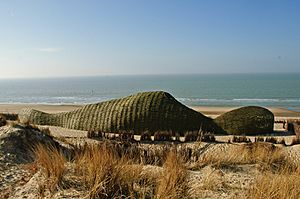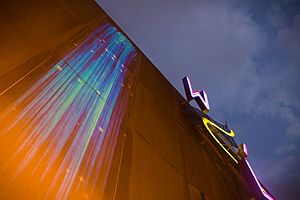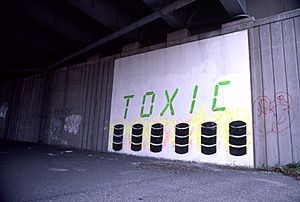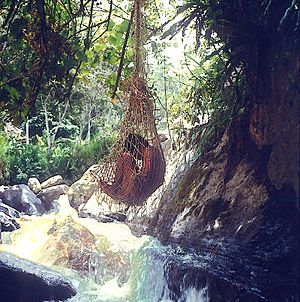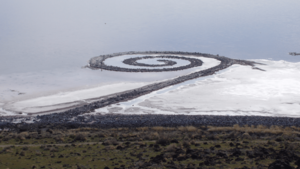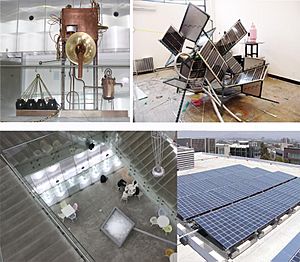Environmental art facts for kids
Environmental art is a special kind of art. It connects artists with nature. This art can be very old, like cave paintings. It can also be new, focusing on our planet's health. Environmental art has changed over time. It used to be about making big sculptures from earth. Now, it often explores how art, nature, and people are connected. Since the 1990s, this art has also focused on healing nature. Today, environmental art is shown all over the world. It helps us think about climate change and our planet.
The term "environmental art" often includes ideas about ecology. Ecology is the study of how living things interact with their environment. But environmental art is not just about ecology. It mostly celebrates an artist's bond with nature. Artists often use natural materials in their work. This type of art is linked to older "Land art" and the newer field of ecological art. Environmental artists often use ideas from science and philosophy. They use many different art forms. This art can be found in the countryside, in suburbs, or even in cities.
Contents
History: Art Inspired by Nature
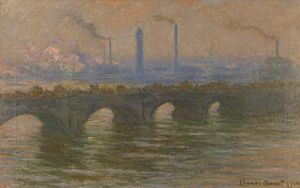
Some people think environmental art started a long, long time ago. Our ancestors made Paleolithic cave paintings. These paintings showed animals and people. They were early observations of nature. For many centuries, nature was a favorite topic for artists.
More recent environmental art comes from landscape painting. When artists painted outdoors, they felt a deep connection to nature. They saw how the weather changed things. They brought these observations into their paintings. For example, John Constable painted skies that looked very real. Claude Monet's London Series also shows his connection to nature. He said, "A landscape changes every moment. The air and light bring it to life."
Today, artists like Diane Burko paint natural events. They show how nature changes over time. This helps people think about climate change. Alexis Rockman creates landscapes that show a strong view of climate change. He also shows how humans change other species.
New Ways to Make Sculptures
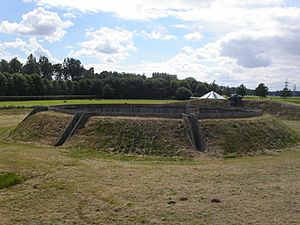
Environmental art became a "movement" in the late 1960s and early 1970s. At first, it was mostly about sculpture. This included site-specific art, Land art, and Arte povera. Artists felt that old ways of making sculptures were not working anymore. They also felt these old ways might harm nature.
In 1968, Robert Smithson had a show called "Earthworks" in New York. The artworks were very big. They were too large to be bought and put in a home. Most were only shown through photographs. This showed that the art was not meant to be owned. Artists wanted to leave city galleries. They went out into the desert to create art.
These artists were not just painting landscapes. They were working with the landscape. Their art was not just about the landscape. It was in the landscape. This change in the 1960s and 1970s was new. It changed how people thought about sculpture and nature. It also challenged how art was shown and sold. This opened up new ways to document and understand art.
Art in Public and City Spaces
Land art started in deserts. But by the late 1970s, artists began to bring environmental art into public spaces. They started working in cities. This helped them share ideas about the environment with more people. Artists like Robert Morris worked with local governments. They created art in public places, like old gravel pits.
Herbert Bayer created his Mill Creek Canyon Earthworks in 1982. This project helped control erosion. It also held water during heavy rains. And it became a park in dry seasons. Lucy Lippard wrote a book about land art and ancient sites. She showed how old cultures influenced new artists working with land.
In 1965, Alan Sonfist had a great idea. He wanted to bring nature back into cities. He proposed his Time Landscape sculpture in New York City. It was finished in 1978. This artwork is still there today. It's a slowly growing forest. It shows what Manhattan looked like when Native Americans lived there.
Environmental art also includes city landscapes. Mary Miss started making art in cities in 1969. Her project Ropes/Shore was an early example. She continues to create projects that involve communities. Agnes Denes planted a field of wheat in downtown Manhattan in 1982. This was called Wheatfield - A Confrontation. She planted it on a landfill filled with trash. That area is now Battery Park City. It changed from a natural space to an economic center.
In 1974, Bonnie Sherk created The Farm in San Francisco. It was a 7-acre urban garden. It was in unused spaces under freeway overpasses. Until 1980, The Farm was a community center and art space. It taught children about ecoart. It was also a public park.
Andrea Polli's Particle Falls made tiny particles in the air visible. People walking by could see the pollution. For HighWaterLine, Eve Mosher walked through cities like New York and Miami. She marked where floods might happen because of climate change. She talked to people about what they could do.
In the 2010s, "guerilla gardener" Ron Finley started planting gardens. He planted them in South Central Los Angeles. He planted them in small dirt strips by the sidewalk. He wanted to help people get healthy food. He especially wanted to help children eat better.
Ecoart: Art for a Healthy Planet
Ecological art, or ecoart, is an art practice. It focuses on ways to live that are good for our planet. It includes artists, scientists, thinkers, and activists. They all work on ecological art. It builds on older art forms like Land Art and landscape painting. Ecoart focuses on how everything in our environment is connected. This includes nature, geography, politics, biology, and culture.
Ecoart helps people become aware of environmental issues. It starts conversations. It tries to change how humans treat other species. It encourages respect for nature. It can be art that involves communities. It can be activist art. It can also be art that helps heal damaged places. Ecological artist Aviva Rahmani says ecoart often works with scientists and city planners. It directly helps fix environmental problems.
There are many ways to make ecoart:
- Artworks that show environmental issues through pictures and objects.
- Projects that clean up polluted areas.
- Activist projects that get people involved to make changes.
- Art that involves communities in watching their local environment.
- Art that helps us see the natural world in a new, magical way. This inspires healing.
- Artworks that use natural things like water, wind, or plants.
- Art that teaches people about environmental problems. This includes pollution and health dangers.
- Art that explores living in a sustainable way.
Some ecoartists discuss if ecoart should be a separate art type. The EcoArtNetwork defines ecoart. They say it is art that cares about social fairness. It wants to inspire care and respect. It also wants to encourage the long-term health of our social and natural environments. It often involves communities and activism. The ArtTech NatureCulture group has over 400 creative people. They use art, design, science, and technology. They want to find new ways to solve problems. Co-founder Kit Braybrooke said, "Alone, we face climate grief. But together, we rebuild."
Artists in this field often follow these ideas:
- They focus on how everything in our environment is connected. This includes physical, biological, cultural, political, and historical parts.
- They use natural materials or work with natural forces like wind or sunlight.
- They help restore damaged environments.
- They teach people about nature and environmental problems.
- They imagine new ways for us to live with nature. They promote healing.
Women have made important contributions to EcoArt. The Women Environmental Artists Directory (WEAD) was started in 1995. It lists many of these artists. Many women artists were inspired by ecofeminist writers. These writers talked about a more equal relationship with nature. Art writer Lucy Lippard noted that many artists in her 2007 show were women. These artists worked with environmental, ecological, and ecofeminist art ideas.
Thinking About Environmental Impact
In environmental art, it's important to think about how the art affects nature. Some artists might not think about the damage their art could cause. Others want to make sure their art does no harm. For example, Robert Smithson's famous sculpture Spiral Jetty (1969) is beautiful. But he used a bulldozer to change the land. This caused lasting damage to the lake area.
Similarly, Christo wrapped a coastline in Australia in 1969. This caused criticism from people who cared about nature. This made artists in the area rethink land art. They started to think more about protecting the environment.
Sustainable art is made by thinking about its wider impact. This includes its effect on society, economy, and nature. Some artists try to cause very little harm. Other artworks even help restore the landscape to its natural state.
British sculptor Richard Long makes temporary outdoor sculptures. He uses natural materials like rocks and branches. He rearranges them on site. His work leaves no lasting damage. Chris Drury created "Medicine Wheel". He walked every day for a year. He collected natural objects. He then arranged them into a mandala. This shows art as a process.
Leading environmental artists like Hamish Fulton, herman de vries, John Davis, and Andy Goldsworthy also leave nature unharmed. Sometimes, they even plant native plants on damaged land. This shows their care for the environment.
One of the most famous environmental art pieces was 7000 Oaks. Joseph Beuys created it in 1982. He and his helpers planted 7000 oak trees. They planted them in and around the city of Kassel. This project brought attention to the local environment.
Ecological Awareness and Change
Other eco-artists think about how humans interact with nature. They create art that focuses on change or healing. Writer Linda Weintraub uses the term "cycle-logical." This links recycling with how we think and feel. She mentions Sarah Sze. Sarah Sze uses trash and discarded items. She turns them into beautiful art installations. Her art makes us think about our own lives. It makes us think about how much we consume. Brigitte Hitschler's Energy field used power from a waste heap. This power lit up 400 red lights. It used art and science to show hidden materials.
Ecological artist Beverly Naidus creates art about environmental problems. She also makes art about nuclear waste. Her project Eden Reframed helps clean up polluted soil. It uses plants and mushrooms. It becomes a public place to grow medicinal and edible plants. Naidus teaches at the University of Washington Tacoma. She created a program that combines art, ecology, and community work. Her book Arts for Change is a great resource for teachers and artists. Sculptor Erika Wanenmacher makes art about creativity and myths. She also addresses nuclear issues in New Mexico. Oregon artist Richard Reames uses tree grafting. He shapes trees into sculptures and buildings. These works help store carbon dioxide. They also create habitats and fight climate change.
Art with Renewable Energy
Renewable energy sculpture is a new type of environmental art. People are worried about global climate change. So, artists are creating art that also generates or saves energy. These artists often follow Ecodesign rules. They make art that is both beautiful and useful.
Andrea Polli's Queensbridge Wind Power Project is an example. It puts wind turbines into a bridge. This helps light the bridge and nearby areas. Ralf Sander's World Saving Machine is a public sculpture. It used solar energy to make snow and ice. It did this outside the Seoul Museum of Art during a hot Korean summer.
See also
 In Spanish: Arte ambiental para niños
In Spanish: Arte ambiental para niños
- BioArt
- Crop art
- Ecodesign
- Ecofeminist art
- Ecological art
- Ecopsychology
- Ecovention
- Environmental movement
- Environmental sculpture
- Environmentalism
- Land art
- Process art
- Site-specific art
- Solarpunk
- Sustainable art
- Sustainable design


